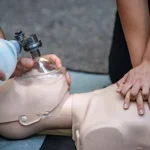
- Last Updated On: September 18, 2024
Understanding BVM Ventilation In Detail
Among several skills of healthcare professionals, bag mask ventilation is another crucial skill that is necessary in emergencies where patients are not able to breathe on their own. Their lifesaving technique involves using a self-inflating bag, mask and an oxygen source to deliver air to the patient’s lungs. It is commonly used during cardiac arrests, respiratory failures or other emergencies that need immediate intervention to maintain oxygen flow.
Mastering Bag Valve Mask Ventilation ensures that healthcare providers can offer efficient respiratory support during critical times. The tool is used in several healthcare settings, including ambulances, hospitals and in-home care for patients with chronic respiratory conditions.
Explore the detailed steps of how BVM ventilation works and essential tips to ensure proper technique. Read the blog to gain a deeper understanding of reasons why BVM ventilation is so important and learn effective ways to use it.
What is BVM ventilation and when is it used?
Bag Valve Mask (BVM) ventilation is a manual method used to help patients who are unable to breathe on their own. It involves using a hand-held device consisting of a mask, a bag, and sometimes an oxygen source, to deliver air or oxygen directly into a patient’s lungs.
BVM ventilation is commonly employed in emergency situations like cardiac arrest, respiratory failure, or during resuscitation efforts, where immediate intervention is needed to maintain proper oxygen levels. It is crucial when a patient’s breathing is compromised, and quick action is required to keep their airways open and ensure they receive adequate ventilation.
What are the proper techniques for bag valve mask ventilation?
BVM needs proper technique, ensuring oxygen delivery. Use the right methods to master key steps, including the following:
Positioning the Head and Neck
Position the device properly to ensure that the airway is open. The patient’s head should be tilted back slightly with the chin lifted to prevent airway obstruction. In cases where spinal injury is suspected, use a jaw thrust technique to avoid moving the neck.
Sealing the Mask
Achieving a proper mask seal is critical for effective ventilation. Use a “C-E” grip with your hand, where your thumb and index finger form a “C” around the mask, and your other fingers form an “E” to lift the jaw.
Squeezing the Bag
When squeezing the bag, do so gently and slowly, allowing enough time for the chest to rise and fall. Deliver breaths over one second to avoid over-inflating the lungs, which can cause complications.
What are the recommended BVM ventilation rates?
The recommended BVM ventilation rate usage is crucial to ensure that the patient receives the right amount of oxygen without causing any harm. The recommended rates vary depending on the conditions and the age of the patient:
Adults
For adults in respiratory arrest, the recommended BVM ventilation rate is one breath every 5 to 6 seconds, or about 10 to 12 breaths per minute. It is important to ensure each breath is delivered slowly and steadily, allowing the chest to rise.
Children
For children, the recommended rate is one breath every 3 to 5 seconds, or 12 to 20 breaths per minute. As children’s lung capacity is smaller, using a smaller bag or reducing the force of the squeeze is critical to avoid over-inflation.
Infants
For infants, BVM ventilation should be administered at a rate of one breath every 3 to 5 seconds, with a focus on using minimal force due to their delicate lungs. This amounts to 12 to 20 breaths per minute, similar to children, but with even smaller volumes of air delivered.
What are the common mistakes in BVM ventilation and how to avoid them?
Bag valve mask is a crucial procedure, and wrong techniques can be very harmful. Here are some common mistakes to know and avoid them well on time.
Improper Mask Seal Mistake:
A poor mask seal can cause air to leak, reducing the effectiveness of ventilation.
How to Avoid: Use the “C-E” grip to create a tight seal between the mask and the patient’s face. Ensure your hand positioning is firm, lifting the jaw upwards rather than pushing the mask down.
Excessive Bag Squeezing Mistake:
Squeezing the bag too quickly or forcefully can lead to over-inflation, increasing the risk of lung injury or gastric inflation.
How to Avoid: Deliver slow, controlled breaths over 1 second, watching for chest rise. Be mindful not to apply too much pressure, especially in children and infants.
Incorrect Ventilation Rate Mistake:
Ventilating too quickly or too slowly can result in inadequate oxygenation or hyperventilation.
How to Avoid: Follow recommended ventilation rates—one breath every 5 to 6 seconds for adults, and adjust according to the patient’s age and condition. Use a timer or count seconds to maintain the correct pace.
What are the tips to improve your BVM ventilation skills?
You need to master BVM ventilation by practicing skills properly. Here are some advanced tips to help you deliver effective ventilation and offer better care:
Ensure Optimal Head Positioning
A patient’s airway can be easily blocked if their head isn’t positioned correctly. Always ensure the head is tilted back slightly with the chin lifted to maintain a clear airway. If spinal injury is suspected, use a jaw-thrust maneuver without tilting the head.
Use Two-Person Technique When Possible
When available, a second person can assist with creating a better mask seal. One person can focus on sealing the mask while the other handles squeezing the bag, ensuring both tasks are performed efficiently. This technique improves overall ventilation quality, especially with difficult airways.
Monitor Chest Rise and Fall
Watching the chest rise and fall is essential for assessing the effectiveness of ventilation. Ensure the chest rises with each breath but avoid excessive rise, which could indicate over-inflation. Proper chest movement confirms that air is reaching the lungs effectively.
Incorporate Supplemental Oxygen
Whenever possible, connect the BVM to an oxygen source to enhance ventilation. This increases the concentration of oxygen delivered, especially in critical situations. Ensure the oxygen flow rate is set between 10-15 liters per minute for maximum benefit.
Practice in Simulated Scenarios
Regular practice in simulated emergency situations helps refine your BVM skills. Training with different patient scenarios—such as difficult airways or trauma patients—prepares you for real-life emergencies. Consistent practice builds confidence and ensures readiness during high-pressure events.
How to get BVM ventilation training?
By now you must have understood the importance of BVM ventilation for healthcare professionals. Fortunately, there are several ways to gain BVM ventilation training:
Attend Healthcare Certification Courses
Many organizations offer certification courses that include BVM assisted ventilation as part of their Advanced Cardiovascular Life Support or Basic Life Support training. These courses provide hands-on practice and professional guidance from certified instructors.
Join Hospital or Medical Facility Training Programs
Most hospitals and medical institutions conduct in-house training sessions for healthcare workers, where BVM ventilation is taught. These programs often offer practical experience and the opportunity to learn from experienced healthcare providers.
Enroll in Online Learning with In-Person Skills Testing
Some certification programs allow you to complete the theoretical portion of ventilation BVM training online and schedule in-person skills testing. This hybrid option offers flexibility while ensuring you receive the hands-on practice needed to perform BVM ventilation correctly.
Conclusion
BVM ventilation is crucial for healthcare professionals, especially during emergencies. Study the techniques well and know the proper techniques for effective oxygenation. Avoid the common mistakes and practice regularly to enhance skills and be more confident. So have a solid grasp of BVM ventilation to respond effectively during emergencies and provide necessary care.
Also read: Mastering High Quality CPR: Essential Techniques and Tips
Also read: The Ultimate Guide to Infant CPR Ratios




